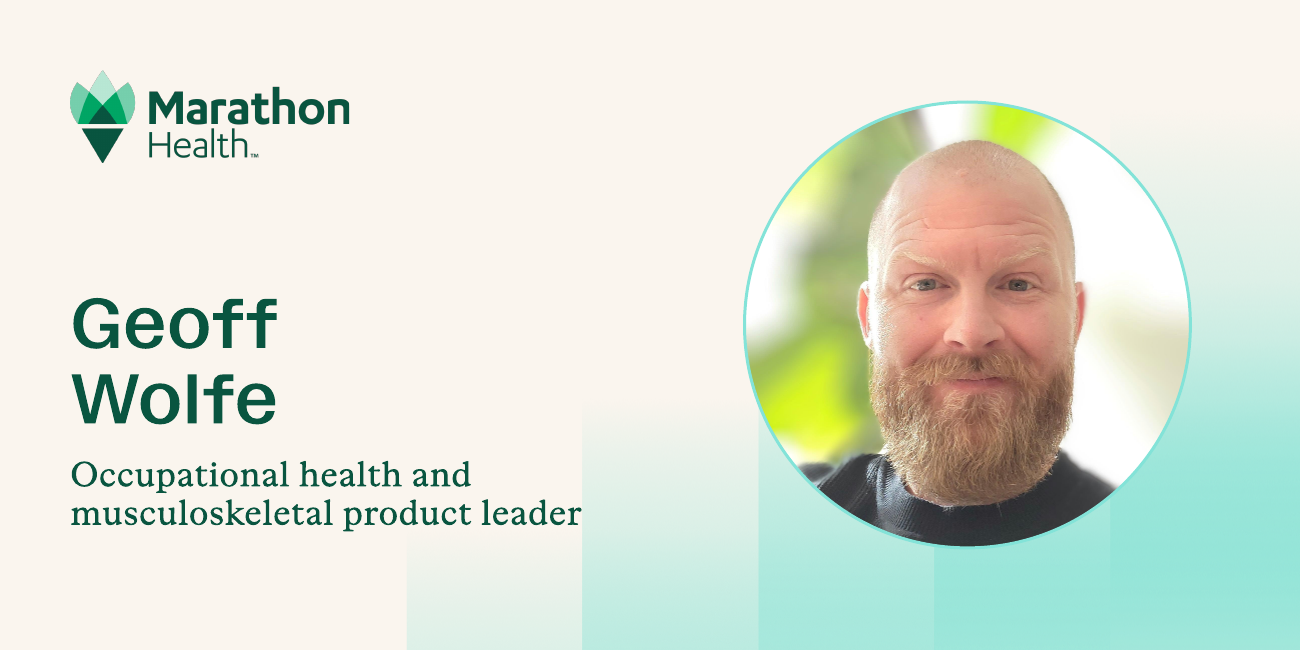Search for topics or resources
Enter your search below and hit enter or click the search icon.
October 28th, 2025 | 6 min. read
By Geoff Wolfe

For the last 15 years, I’ve focused on the intersection of worker health, safety, and performance. I’ve sat in rooms with plant managers, school administrators, city leaders, and labor organizations who are all wrestling with the same challenges: budgets under pressure, health conditions—mental health, chronic conditions, musculoskeletal illness—on the rise, and recruitment and retention challenges impacting day-to-day operations.
The lesson that comes up again and again is simple: when we see the whole person, not just the injury, through the lens of Total Worker Health and whole-person care, everything works better—fewer incidents, faster recovery, lower cost, stronger retention, better business performance.
Human health is fundamentally interconnected with our environment—it transcends the boundaries of home or work. Yet the traditional healthcare system attempts to bucket “workplace health and safety” and “personal health and wellness” into two distinct domains rather than around the central human being.
A broken system has left both human resources (HR) functions and environmental health and safety (EHS) teams—who share a common goal to ensure the workforce is safe and productive—to face a perfect storm of confounding challenges.
%20(5).png?width=800&height=207&name=WorkSafe%20Blog%201%20--%20Image%20Blades%20(800%20x%20207%20px)%20(5).png)
These aren’t issues that neatly fit into the box of benefits versus safety, or home versus work. Consider a common scenario: a single working parent who is 65 pounds overweight, prediabetic, has low-back pain, poor sleep, and high financial stress. If that person experiences burnout and their body starts to fail, it’s a matter of chance whether the eventual health issue or injury will hit workers’ compensation or health plan claims.
Every avoidable Days Away, Restricted, or Transferred (DART) case, preventable absence, or friction point in return-to-work exacerbates a talent market that’s already tight. Addressing holistic health and well-being with the lens of prevention is no longer a nice-to-have, but a talent magnet and massive economic opportunity—it’s your competitive advantage.
%20(2).png?width=800&height=207&name=WorkSafe%20Blog%201%20--%20Image%20Blades%20(800%20x%20207%20px)%20(2).png)
Developed by the National Institute for Occupational Safety and Health (NIOSH), Total Worker Health® is a framework that combines protection from work hazards with the promotion of health and well being—addressing the physical, psychosocial, and organizational conditions of work. It’s a mindset shift from treating worker and personal health as separate silos to managing them as one system.
When I talk to employers about Total Worker Health, three misconceptions often arise:
Consider a patient, diagnosed with a heart murmur in childhood and never treated again, who needed his DOT physical. What happens in a traditional, transactional model? Do the physical, check the box, send the patient on their way. Our Total Worker Health model gives providers—adept in both primary care and occupational health—the time and tools to understand patients’ unique needs. When this patient came to our health center, the provider noticed the murmur and escalated an immediate, high-value cardiology referral. It’s moments like these that illuminate the value of a whole-person care approach.
%20(3).png?width=800&height=207&name=WorkSafe%20Blog%201%20--%20Image%20Blades%20(800%20x%20207%20px)%20(3).png)
Think of occupational health as your mandatory touchpoint: pre-employment, surveillance, injury triage, fit for duty, return-to-work. Each touchpoint is an opportunity to screen, coach, and navigate into advanced primary care for conditions that left untreated, will become tomorrow’s recordables or high-cost claims.
Begin by creating one cross-functional team—HR, Benefits, Risk, EHS—with a single shared goal: fewer injuries, faster recovery, and healthier employees.
Here are practical steps to take when designing a Total Worker Health framework at your organization:
If you do one thing this quarter: Start with an internal audit—use NIOSH’s Worker WellBeing Questionnaire (WellBQ) to establish a baseline of culture, hazards, health access, and outcomes. Then pick three high-leverage changes (e.g., early MSK program, mental health navigation, ergonomics pipeline) to focus on.
I’ve seen this transformation at many organizations, and it’s powerful—for both employees and the business. Among our clients that offer occupational health alongside advanced primary care, we see 15% higher employee engagement. With Briggs & Stratton, a leading manufacturer, we implemented a Total Worker Health approach and are seeing an impact on both their healthcare and injury-related costs.
In this example, the employer offers advanced primary care, occupational health, and physical therapy at an onsite health center. They’ve established an early reporting culture where proactive symptom intervention is commonplace. There isn’t any stigma for seeking care, in fact, it’s rewarded.
So, what happens when a distribution teammate reports early low-back soreness to the onsite provider? Within hours a clinician evaluates, applies OSHA first aid, adjusts the job setup, and coordinates a warm referral into primary care for weight care, sleep, and metabolic risk.
The result: no recordable, no DART, full duty within days, and (in a few months) improved A1C and sleep because the root issues were addressed, not just the symptoms.
These “save the claim” moments add up. Briggs & Stratton has seen results like 40% fewer OSHA recordables, 47% lower DART rate, and 40% lower average injury claim cost. Additionally, members who engaged with Marathon had 16% lower healthcare costs. At scale, integrated models like WorkSafe™ by Marathon Health drive organizational transformation.
The future of work brings new challenges. With rapid advancements in technology, we’re moving beyond an era dominated by heavy, high-risk physical work into one that’s more sedentary and cognitively demanding—with psychosocial risks rising as fast as MSK. Ensuring the health, durability, and longevity of the workforce isn’t just good corporate citizenship, it’s the backbone of productivity and competitiveness. Total Worker Health and whole-person care improve quality of life and economic output—and an organization is nothing without its people.
Want to see what this looks like in practice? Download our case study to learn how integrated care reduced injuries, improved return-to-work times, and strengthened workforce stability.
If you do one thing this quarter: Start with an internal audit—use NIOSH’s Worker WellBeing Questionnaire (WellBQ) to establish a baseline of culture, hazards, health access, and outcomes. Then pick three high-leverage changes (e.g., early MSK program, mental health navigation, ergonomics pipeline) to focus on.